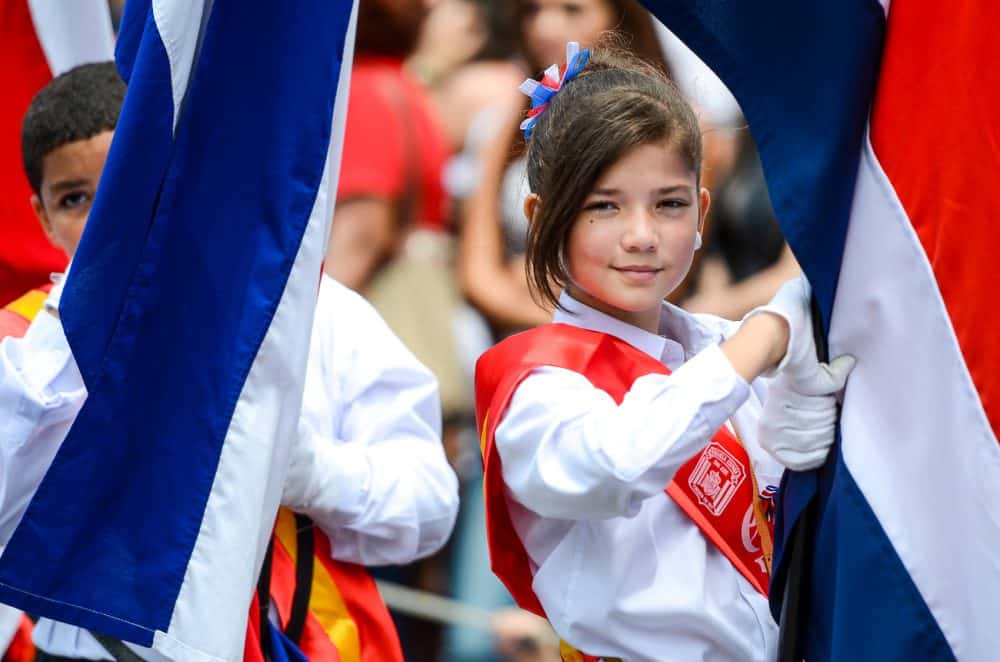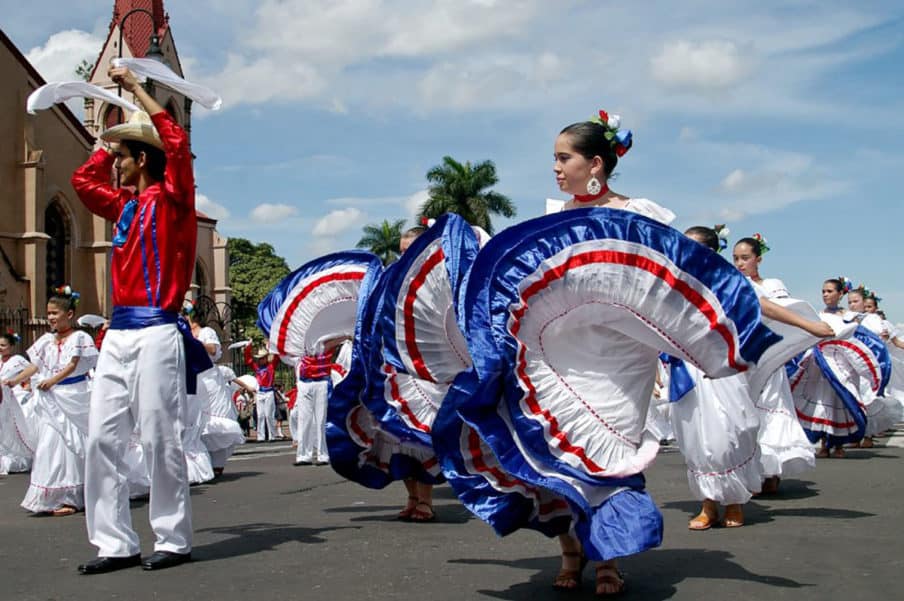
Every September, Costa Rica bursts into a month-long celebration of its independence from Spain, marked officially on September 15, 1821. This vibrant holiday, shared with Guatemala, El Salvador, Honduras, and Nicaragua, is a time when Ticos (Costa Ricans) showcase their national pride, rich culture, and love for community.
Whether you’re a history buff, a culture enthusiast, or a traveler planning a visit, Costa Rica’s Independence Day offers a unique window into the heart of this peaceful nation. In this guide, we’ll dive into the history of Costa Rica’s independence, explore how Ticos celebrate, highlight must-see activities, and share practical tips for visitors. Let’s see why September is the perfect time to experience Costa Rica’s pura vida spirit!
The Road to Freedom: Costa Rica’s Independence History
Costa Rica’s journey to independence is a fascinating tale of timing, geography, and peaceful resolve. Unlike many Latin American nations that fought bloody wars for freedom, Costa Rica’s path was remarkably nonviolent, reflecting its enduring commitment to peace.
In the early 1800s, Costa Rica was a remote province of the Captaincy General of Guatemala, under Spanish colonial rule since the 16th century. The seeds of independence were sown by global events: the American and French Revolutions inspired cries for liberty, while Napoleon’s invasion of Spain in 1808 weakened the Spanish Empire’s grip on its colonies. Mexico’s War of Independence (1810–1821) further set the stage, as its success emboldened Central American leaders.
On September 15, 1821, representatives from Central America gathered in Guatemala City and signed the Act of Independence, declaring Guatemala, El Salvador, Honduras, Nicaragua, and Costa Rica free from Spanish rule. This historic moment, driven by a mix of peninsulares (Spaniards born in Spain) and criollos (American-born Spaniards), was celebrated in Guatemala with fervor.
However, Costa Rica’s isolation meant the news didn’t reach its people until October 13, 1821, when a messenger arrived on horseback in Cartago, the colonial capital. The delay, due to slow travel across rugged terrain, is a quirky footnote in Costa Rican history.
On October 29, 1821, Costa Rican leaders in Cartago held a cabildo abierto (open town meeting) and formally ratified their independence, with José Santos Lombardo securing the city’s arsenal to ensure a peaceful transition. This nonviolent approach set Costa Rica apart, aligning with its later decision to abolish its army in 1948. Post-independence, Costa Rica briefly joined the Mexican Empire (1821–1823) and then the Federal Republic of Central America (1823–1838).
Political instability and regional rivalries led to the republic’s collapse, and in 1838, Costa Rica declared full sovereignty under leaders like Braulio Carrillo Colina. The country’s first elected Chief of State, Juan Mora Fernández, laid the groundwork for progress by promoting coffee production and education, shaping Costa Rica’s identity as a stable, forward-thinking nation.
A lesser-known chapter followed in 1856, when Costa Rica defended its independence against William Walker, an American filibuster who attempted to conquer Central America. The Battle of Rivas, where national hero Juan Santamaría set fire to enemy barricades, secured Costa Rica’s freedom and cemented Santamaría’s legacy. Today, his bravery is celebrated as a symbol of Tico resilience. This rich history, from a delayed independence announcement to a heroic defense, makes September 15 a day of deep pride for Costa Ricans.
How Costa Rica Celebrates Independence Day
September in Costa Rica is known as Mes de la Patria (Homeland Month), a time when the country drapes itself in red, white, and blue—the colors of the national flag, symbolizing love, wisdom, and perseverance. The celebrations are family-oriented, peaceful, and brimming with cultural traditions, making them a highlight for locals and visitors alike. Festivities kick off well before September 15 and continue with parades, music, and food, creating an atmosphere of unity and joy.
One of the most iconic traditions is the Torch Run, a relay that begins on September 9 in Guatemala. A “freedom torch,” symbolizing the spread of independence news in 1821, is lit at the Obelisco monument in Guatemala City. High school students, escorted by police, carry the torch on foot through Honduras, El Salvador, Nicaragua, and finally to Cartago, Costa Rica, arriving on September 14. Approximately 20,000 students participate annually, passing the torch hand-to-hand in a powerful display of regional unity. On the evening of September 14, at precisely 6 p.m., the torch reaches Cartago, where it lights a cauldron. Simultaneously, Costa Ricans nationwide pause to sing the national anthem, broadcast on TV and radio, in a moving moment of patriotism.
Following the anthem, the Desfile de Faroles (Lantern Parade) lights up the streets. This tradition honors María Dolores Bedoya, a Guatemalan woman who rallied support for independence in 1821 by carrying a lantern through Antigua’s streets.
Schoolchildren craft faroles—homemade lanterns made from recycled materials, often shaped like houses, oxcarts, or patriotic symbols—and decorate them with stickers, drawings, and LED lights. As dusk falls, families join the parade, with kids proudly displaying their glowing creations. The parade, accompanied by traditional music and folk dances, is a heartwarming celebration of youth and heritage.
On September 15, the official Independence Day, Costa Rica comes alive with vibrant parades. School marching bands, dressed in crisp uniforms, fill the streets with the sounds of drums and lyres. Students perform folkloric dances, such as the punto guanacasteco, while wearing traditional clothing: women in colorful, ruffled skirts and men in white shirts with red sashes and straw hats (chonetes).
Spectators line the sidewalks, cheering and waving flags, as the parades showcase Costa Rica’s cultural diversity, including influences from its seven provinces and Guanacaste, which joined Costa Rica in 1824. Fireworks light up the night sky, capping off the day with a festive flourish.
Must-See Activities and Culinary Delights
Independence Day is a feast for the senses, offering visitors a chance to immerse themselves in Costa Rican culture. Beyond the parades, you’ll find street vendors selling traditional foods that reflect the country’s culinary heritage.
Try casados (a plate of rice, beans, plantains, salad, and a protein like chicken or beef), tamales wrapped in banana leaves, or empanadas stuffed with cheese or meat. For a taste of the tropics, try arroz con pollo (rice with chicken), yuca frita (fried cassava), or patacones (fried green plantains). Sweet treats like arroz con leche (rice pudding), flan de coco (coconut flan), and tres leches (a soaked sponge cake) are festival favorites. These dishes, often sold at roadside stands, are a delicious way to connect with Tico traditions.
Cultural events at community centers and plazas offer free folkloric shows, live music, and dance performances. In San José, the National Museum hosts exhibits on Costa Rica’s independence, while smaller towns like Santa Elena in Monteverde feature local bands and oxcart parades, a nod to the country’s agrarian past. For a unique experience, visit Guanacaste, where the region’s cowboy culture shines through in music and dress, celebrating its 1824 annexation to Costa Rica.
Travelers can also explore historical landmarks tied to independence. The National Museum in San José, housed in a former fortress, displays artifacts from the colonial era, while Cartago’s Basilica de Nuestra Señora de los Ángeles offers a glimpse into the colonial capital’s past. For outdoor enthusiasts, Costa Rica’s natural wonders—rainforests, volcanoes, and beaches—remain accessible, though plan around holiday closures.
What’s Open and Closed on Independence Day

As a national holiday, September 15 brings Costa Rica to a festive standstill. Schools, government offices, banks, and most businesses close, allowing Ticos to celebrate with family and friends. Some supermarkets, pharmacies, and tourist-oriented shops may remain open, especially in popular destinations like San José, Manuel Antonio, or Tamarindo. However, hours may be limited, so stock up on essentials beforehand. Restaurants and bars, particularly in tourist areas, often stay open, offering special Independence Day menus. Public transportation runs on reduced schedules, so confirm routes if you’re traveling.
| Establishment Type | Status on September 15 | Notes |
|---|---|---|
| Schools | Closed | Students participate in parades. |
| Government Offices | Closed | Resume operations on September 16. |
| Banks | Closed | ATMs remain accessible. |
| Businesses | Mostly Closed | Some tourist-oriented shops may open. |
| Supermarkets | Limited Hours | Major chains may open partially. |
| Restaurants/Bars | Open (Varies) | Tourist areas likely to have normal hours. |
| Public Transportation | Reduced Schedules | Check routes in advance. |
Travel Tips for Visiting During Independence Day
September is a fantastic time to visit Costa Rica, as the Independence Day festivities offer an authentic cultural experience. The weather, part of the rainy season, is warm with occasional showers, so pack a lightweight rain jacket and comfortable shoes for parades.
Book rooms early, especially in popular areas like San José, Guanacaste, or the Central Valley, as locals travel to beaches and national parks for the holiday weekend. Joining the celebrations is easy—most events are free and open to the public. Engage with locals, who are known for their warmth, and ask about regional traditions, like Guanacaste’s marimba music or Monteverde’s eco-focused parades.
For a deeper dive, visit Cartago to witness the torch’s arrival or Playa Grande for its sunset lantern parade. If you’re staying at a resort, like Villa Buena Onda in Guanacaste, ask your concierge about local festivities. To fully embrace the pura vida vibe, wave a Costa Rican flag, try a tamale, and join the anthem sing-along at 6 p.m. on September 14. Just be prepared for crowds and plan your itinerary around closures.
Why Independence Day Matters to Costa Rica
Costa Rica’s Independence Day is more than a holiday—it’s a celebration of the nation’s identity as a peaceful, democratic, and environmentally conscious country. The festivities, rooted in history, bring together Ticos of all ages to honor their past and look to the future.
For travelers, it’s a chance to experience Costa Rica’s vibrant culture, from lantern-lit parades to mouthwatering cuisine, all set against the backdrop of lush rainforests and volcanic landscapes. Whether you’re in a bustling city or a quiet beach town, the spirit of Mes de la Patria will leave you inspired.
So, if you’re planning a trip to Costa Rica, aim for mid-September to join the Independence Day celebrations. Immerse yourself in the parades, savor traditional foods, and connect with the Tico spirit of unity and pride. From the torch’s journey to the glow of faroles, Costa Rica’s Independence Day is a memory you’ll treasure long after the fireworks fade. ¡Pura vida!

